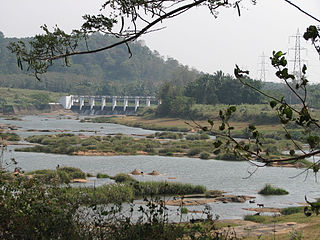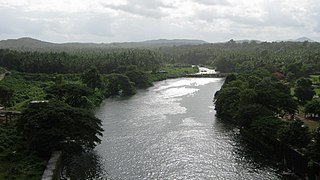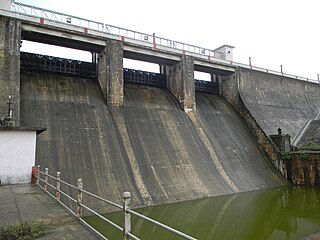Varattar River is one of the tributaries of the river Kalpathipuzha. The Kalpathipuzha is one of the main tributaries of the Bharathapuzha River, the second-longest river in Kerala, south India.
Varattar River is one of the tributaries of the river Kalpathipuzha. The Kalpathipuzha is one of the main tributaries of the Bharathapuzha River, the second-longest river in Kerala, south India.

Thuthapuzha River is one of the main tributaries of the Bharathapuzha River. The source of the river is in the Silent Valley hills. It flows through Malappuram-Palakkad district border. In Mannarkkad region the river is named as the Kunthipuzha that flows through the Silent Valley National Park. Elamkulam, Thiruvegappura, Veliyakulam and Pulamanthole are places of importance situated on the bank of this river.

Gayathripuzha River is one of the main tributaries of the Bharathapuzha River, the second-longest river in Kerala, south India. It originates from Anamala hills, passes through Kollengode, Nenmara (Nemmara), Alathur, Padur and Pazhayannur before joining the Bharathapuzha at Mayannur. It is the second largest tributary of the Bharathapuzha, by both length and discharge. The Gayathripuzha flows mainly through Palakkad district, except for the last few kilometres. The river is non-perennial like its parent river, and is also prone of sand mining. There is a dam built across this river at Cherakkuzhy near Pazhayannur.

The Kalpathy River, also known as the Kalpathipuzha, is one of the main tributaries of the Bharathapuzha River, the second-longest river in Kerala, south India.
Kannadipuzha River is one of the main tributaries of the Bharathapuzha River, the second-longest river in Kerala, south India.

Thiruvegappura is a village in Pattambi Taluk Palakkad district in the state of Kerala, India. It is administered by the Thiruvegapura gram panchayat.

The Kunthipuzha River is a waterway located in the state of Kerala, India. It flows through the Silent Valley National Park. This river is also called the Thuthapuzha by the local population. Kunthipuzha is one of the main tributaries of the Bharathapuzha River, the second-longest river in Kerala. This river is mainly used by the people of Mannarkkad taluk and Pattambi Taluks of Palakkad district and Perinthalmanna Thaluk of Malappuram District. This river is known for the story of bathing of Kunthi devi, the mother of pandavas and so it is named as Kunthippuzha. Another theory is that Kunthippuzha is the shortened form of "Kunthirikkappuzha". "Kunthirikkam" is the Malayalam word for Boswellia serrata which is a kind of frankincense tree seen in this region. In Mannarkkad region this river is called the Kunthipuzha, while when it reaches Malappuram- Palakkad border, locals call it as Thuthapuzha, after a border town, Officially the river is Kunthipuzha

Kanjirappuzha River is one of the tributaries of the river Thuthapuzha. The Thuthapuzha is one of the main tributaries of the Bharathapuzha River, the second-longest river in Kerala, South India.
Thuppanadupuzha River is a river in India. It is one of the tributaries of the river Thuthapuzha. The Thuthapuzha is one of the main tributaries of the Bharathapuzha River, the second-longest river in Kerala, south India.

Mangalam River is the main tributary of the river Gayathripuzha, which in turn is a tributary of Bharathapuzha, the second longest river in Kerala, India. It is around 30 km long in length, with its source in Nelliyampathi forests, and passing through Vadakkencherry, Kannambra, Puthucode, Padur, etc. and joining Gayathripuzha at Plazhi in the border of Thrissur and Palakkad districts.
Ayalurpuzha River is one of the tributaries of the river Gayathripuzha. The Gayathripuzha itself later becomes one of the main tributaries of the Bharathapuzha River, the second-longest river in Kerala, South India.
Vandazhippuzha River is one of the tributaries of the river Gayathripuzha. It gets its name since it flows through the village of Vandazhi in Palakkad district. It has its origin in Nelliyampathy hills and joins Gayathri river near Alathur. Gayathripuzha is one of the main tributaries of the Bharathapuzha River, the second-longest river in Kerala, south India.
Meenkarappuzha River is one of the tributaries of the river Gayathripuzha. The Gayathripuzha in turn is one of the main tributaries of the Bharathapuzha River, the second-longest river in Kerala, south India.
Chulliyar River is one of the tributaries of the river Gayathripuzha. The Gayathripuzha in turn is one of the main tributaries of the Bharathapuzha River, the second-longest river in Kerala, south India.
Korayar River is one of the tributaries of the river Kalpathipuzha, which in turn is a main tributary of the Bharathapuzha River, the second-longest river in Kerala, south India. It originates from Anamalai, Tamilnadu and merges with the Walayar which later converges with the Bharathapuzha at Pattambi.
Malampuzha River is one of the tributaries of the river Kalpathipuzha. Malampuzha Dam is built across the river at Malampuzha about 8 km from the Palakkad city in the Indian state of Kerala. The reservoir formed by the Malampuzha Dam is 23.13 square kilometres in area and is the second largest reservoir in Kerala after the Idukki reservoir. The construction of Malampuzha dam started in the year 1949 and was completed in the year 1955. The project is estimated to have cost around Rs. 53 million. Malampuzha river joins the Kalpathipuzha, a tributary of the Bharathapuzha at Palakkad. Kalpathipuzha then flows westward to join Kannadipuzha at Parali to form Bharathapuzha, which ultimately flows until Ponnani, passing through towns and villages Mankara, Pathirippala, Lakkidi, Thiruvilwamala, Ottapalam, Mayannur, Shoranur, Cheruthuruthy, Thirumittakode, Pattambi, Thrithala, Kudallur, Kuttippuram, Thirunavaya and Chamravattom.

Aliyar is one of the tributaries of the river Kannadipuzha. Kannadipuzha is one of the main tributaries of the river Bharathapuzha, the second-longest river in Kerala, south India. Its source is the Aliyar dam in Aliyar near Pollachi in Tamil Nadu
Cherukunnapuzha is a tributary of the river Mangalam river, passing through Alathur Taluk in Palakkad district. This river joins with some streams to form Mangalam River. Mangalam river is the largest tributary of the river Gayathripuzha which itself is one of the tributaries of the river Bharathapuzha, the second-longest river in Kerala, south India. The river joins Mangalam river near Mangalam Dam and its waters continue with Mangalam river until Plazhi in the border of Thrissur and Palakkad districts, and eventually turns to Gayathripuzha until Mayannur, where it joins Bharathapuzha, and finally reaching the Arabian Sea.

Walayar Dam is a dam in Palakkad district of Kerala, India. This dam is constructed across the Walayar River, which is a tributary of Kalpathipuzha River. It was completed and opened in 1964. It is one of the major sources of irrigation in the region. Most of the water in this river is passed to the inner places of Walayar. The dam holds a larger reservoir area, and the persons living near the reservoir area utilizes the water from the walayar dam as their main water source for irrigation. Currently the water held inside the reservoir is less due to lesser rain at Walayar. The reservoir area is very scenic and has better scope for tourism.

Walayar River is one of the tributaries of the river Kalpathipuzha.It originates in the Sirumalai hills. The Kalpathipuzha is one of the main tributaries of the Bharathapuzha River, the second-longest river in Kerala, India. The Walayar Dam is constructed across this river. It was completed and opened in 1964. The river is by a valley and a garden equipped with a children's play area. Previously, Walayar Dam was as famous as Malampuzha Dam.

The Bharathappuzha, also known as the Nila or Ponnani River, is a river in the Indian states of Tamil Nadu and Kerala. With a length of 209 km, it is the second longest river that flows through Kerala after the Periyar. It flows through Palakkad Gap, which is also the largest opening in the Kerala portion of Western Ghats. The Nila has groomed the culture and life of South Malabar part of Kerala. It is also referred to as the "Peraar" in ancient scripts and documents. River Bharathapuzha is an interstate river and lifeline water source for a population residing in four administrative districts, namely Malappuram and Palakkad districts, and parts of Palakkad-Thrissur district border of Kerala and Coimbatore, and Tiruppur of Tamil Nadu. The fertile Thrissur-Ponnani Kole Wetlands lie on its bank.